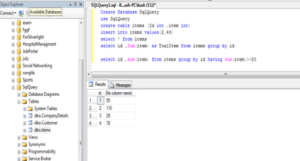REQUEST COMPLIMENTARY SQLS*PLUS LICENCE
SQL SUM function

SQL SUM function is used to return the sum of an expression in the SELECT operator.
Syntax for SUM function in SQL
SELECT SUM(aggregate_expression_id)
FROM tabs
[WHERE conds]
Or syntax for SUM function when grouping results by one or more columns.
SELECT expression1_id, expression2_id, ...expression_n_id,
SUM(aggregate_expression_id)
FROM tabs
[WHERE conds]
GROUP BY expression1_id, expression2_id, ...expression_n_id;
where:
- expression1_id, expression2_id, …_n_id – Expressions that are not encapsulated in the SUM function and must be included in the GROUP BY offer at the end of the SQL query
- aggregate_expression_id – It’s a column or an expression to be summed up
- tabs – The tables from which you want the records. The FROM sentence must contain at least one table
- WHERE conds – It’s optional. These are the conditions that must be met to select records
Single Expression Example
For example, you may want to know how the total gross salary of all employees with salaries in excess of $25,000 per year is.
SELECT SUM(salary_id) AS "Total Salary_id"
FROM empls
WHERE salary_id > 25,000;
In this example of the SQL function SUM we have assigned the alias expression SUM(salary_id) as “Total Salary_id”. As a result “Total Salary_id” will be displayed as a field name when returning the result set.
Using SQL DISTINC
You can use DISTINCT SQL sentence in SUM function. For example, the following SQL statement SELECT returns the total “total salary_id” with unique values where the salary_id exceeds $25000 per year.
SELECT SUM(DISTINCT salary_id) AS "Total Salary_id"
FROM empls
WHERE salary_id > 25,000;
If two salaries were $30,000 per year, the SUM SQL function would use only one of these values.
Using formulas
The expressions contained in the SUM SQL function do not necessarily have to be a single field. You can also use a formula. For example, you may need a net income for your business. Net income_id is calculated as total income_id minus total expenses_id.
SELECT SUM(income_id - expenses_id) AS "Net Income_id"
FROM gl_transactions_id;
You can also execute a mathematical operation in SUM SQL function. For example, you can define total commission as 10% of total sales.
SELECT SUM(sales_id * 0.10) AS "Commission_id"
FROM ord_details;
Using SQL GROUP BY
In some cases you will need to use GROUP BY SQL statement with SUM function.
For example, you can also use SUM SQL function to return the department name and general sales (in a related department_id).
SELECT department_id,
SUM(sales) AS "Total sales_id"
FROM ord_details
GROUP BY department_id;
| Since there is one column specified in SQL statement SELECT, which is not encapsulated in SQL function SUM, you must use SQL statement GROUP BY. |
Therefore the department field must be specified in the GROUP BY SQL statement.
Fundamentals of SQL Using Sum Function
MORE NEWS
PreambleNoSql is not a replacement for SQL databases but is a valid alternative for many situations where standard SQL is not the best approach for...
PreambleMongoDB Conditional operators specify a condition to which the value of the document field shall correspond.Comparison Query Operators $eq...
5 Database management trends impacting database administrationIn the realm of database management systems, moreover half (52%) of your competitors feel...
The data type is defined as the type of data that any column or variable can store in MS SQL Server. What is the data type? When you create any table or...
PreambleMS SQL Server is a client-server architecture. MS SQL Server process starts with the client application sending a query.SQL Server accepts,...
First the basics: what is the master/slave?One database server (“master”) responds and can do anything. A lot of other database servers store copies of all...
PreambleAtom Hopper (based on Apache Abdera) for those who may not know is an open-source project sponsored by Rackspace. Today we will figure out how to...
PreambleMongoDB recently introduced its new aggregation structure. This structure provides a simpler solution for calculating aggregated values rather...
FlexibilityOne of the most advertised features of MongoDB is its flexibility. Flexibility, however, is a double-edged sword. More flexibility means more...
PreambleSQLShell is a cross-platform command-line tool for SQL, similar to psql for PostgreSQL or MySQL command-line tool for MySQL.Why use it?If you...
PreambleWriting an application on top of the framework on top of the driver on top of the database is a bit like a game on the phone: you say “insert...
PreambleOracle Coherence is a distributed cache that is functionally comparable with Memcached. In addition to the basic function of the API cache, it...
PreambleIBM pureXML, a proprietary XML database built on a relational mechanism (designed for puns) that offers both relational ( SQL / XML ) and...
What is PostgreSQL array? In PostgreSQL we can define a column as an array of valid data types. The data type can be built-in, custom or enumerated....
PreambleIf you are a Linux sysadmin or developer, there comes a time when you need to manage an Oracle database that can work in your environment.In this...
PreambleStarting with Microsoft SQL Server 2008, by default, the group of local administrators is no longer added to SQL Server administrators during the...















